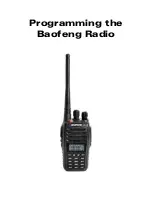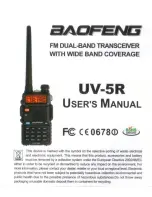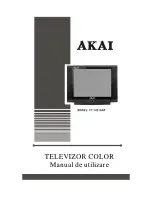
3 - 8
3-3 FREQUENCY SYNTHESIZER (PLL UNIT)
REFERENCE FREQUENCY OSCILLATOR CIRCUIT
The cr ystal oscillator (X151) generates the 32 MHz
reference frequency signal. This reference signal is applied
to the Local Oscillator (LO) circuits, through the buffer (Q151)
and LPF (L153, C156–158).
3RD TX LO CIRCUIT
The 32 MHz reference signal from the crystal oscillator
(X151) is doubled by the doubler (Q551, L551, L552),
resulting in the 64 MHz reference clock signal. Using the
64 MHz reference clock signal, the 491 kHz 3rd TX LO
signal is directly generated by 10-bit DDS-A (IC702) and D/A
converter (R703–R722). The generated 491 kHz 3rd TX LO
signal is passed through the LPF (L702, C713, C715), buffer
(Q701), LO SW (D851), BPF (L851–L853, C851, C853,
C855, C856, C858), and then applied to the MAIN UNIT.
2ND TX LO CIRCUIT
The 32 MHz reference signal from the reference frequency
oscillator circuit is doubled by the doubler (Q551, L551,
L552) to extract the 64 MHz of 2nd harmonic component. The
64 MHz signal is applied to the MAIN UNIT as the 2nd TX LO
signal, through the buffer (Q571).
The 2nd TX LO signal is amplified by the LO AMP (MAIN
UNIT: IC3675), and then applied to the 2nd TX mixer (MAIN
UNIT: D3671).
2ND RX LO CIRCUITS
• HF BAND
The 32 MHz reference signal from the reference frequency
oscillator circuit is doubled by the doubler (Q551, L551,
L552), to extract the 64 MHz of 2nd harmonic component. The
64 MHz signal is amplifi ed by the LO AMP (Q901), and then
mixed with the 491 kHz signal from the 3rd TX LO circuit, by
the 2nd RX LO mixer (D951), resulting in the 64.491 MHz
2nd RX LO signal. The 2nd RX LO signal is fi ltered by the
crystal fi lter (FI981), and then applied to the RF-A UNIT as
the 2nd RX LO signal.
The 2nd RX LO signals which are 90 degrees phase-shifted
from each other, are applied to the 2nd IF mixers (RF-A
UNIT; D1101 and D1102), through the buffers (RF-A UNIT;
IC1121).
• VHF BAND
The 32 MHz reference signal from the crystal oscillator
(X151) is doubled by the doubler (Q551, L551, L552),
resulting in the 64 MHz reference clock signal. Using the
64 MHz reference clock signal, the 10.814 MHz 2nd RX
LO signal is directly generated by 10-bit DDS-A (for MAIN
BAND; IC702, for SUB BAND; IC1502) and D/A converter (for
MAIN BAND; R703–R722, for SUB BAND; R1503–R1522).
The generated 10.814 MHz 2nd RX LO signal is passed
through the LPF (for MAIN BAND; L702, C713, C715, for
SUB BAND; L1521, C1509, C1511), buffer (for MAIN BAND;
Q701, for SUB BAND; Q1501), LO SW (for MAIN BAND;
D1701, for SUB BAND; D1702), BPF (L851–L853, C851,
C853, C855, C856, C858), and then applied to the RF-B
UNIT.
The 2nd RX LO signals which are 90 degrees phase-shifted
from each other, is applied to the 2nd IF mixers (RF-B UNIT;
D251 and D255), through the LO AMP (RF-B UNIT; Q201),
buffers (RF-B UNIT; IC211).
• UHF BAND
The 32 MHz reference signal from the crystal oscillator
(X151) is doubled by the doubler (Q551, L551, L552),
resulting in the 64 MHz reference clock signal. Using the
64 MHz reference clock signal, the 10.814 MHz 2nd RX
LO signal is directly generated by 10-bit DDS-A (for MAIN
BAND; IC702, for SUB BAND; IC1502) and D/A converter (for
MAIN BAND; R703–R722, for SUB BAND; R1503–R1522).
The generated 10.814 MHz 2nd RX LO signal is passed
through the LPF (for MAIN BAND; L702, C713, C715,
for SUB BAND; L1521, C1509, C1511), buffer (for MAIN
BAND; Q701, for SUB BAND; Q1501), LO SW (for MAIN
BAND; D1801, for SUB BAND; D1802), BPF (L1801–L1803,
C1803, C1805, C1807, C1808, C1810), and then applied
to the 2nd RX LO mixer (D1872) to be mixed with the 64
MHz reference signal from the buffer (Q1851), resulting in
the 71.214 MHz 2nd RX LO signal. The 2nd RX LO signal is
applied to the RF-B UNIT, through the BPF (FI1881).
The 2nd RX LO signals which are 90 degrees phase-shifted
from each other, is applied to the 2nd IF mixers (RF-B UNIT;
D651 and D655), through the LO AMP (RF-B UNIT; Q601),
buffers (RF-B UNIT; IC611).
1ST RX/TX LO CIRCUITS
The 32 MHz reference signal from the reference frequency
oscillator circuit is amplifi ed by Q201, and applied to the PLL
IC (IC201) as the reference frequency signal.
The VCO (Q251), which is controlled by the PLL IC (IC201),
generates the 388.5 MHz master clock signal, by using the
applied 32 MHz signal as the reference.
The generated 388.5 MHz master clock signal is passed
through the buffers (Q271, for MAIN BAND; Q301, for
SUB BAND; Q1001) which provide the isolation between
the DDS-A (IC351) and DDS-B (IC1051), and BPF (for
MAIN BAND; L301–L304, C305–C312, for SUB BAND;
L1001–L1004, C1005–C1011), and then applied to the
DDS-A (for MAIN BAND; IC351, for SUB BAND; IC1051).
Using the applied DDS master clock signal as the referece,
the DDS-A/DDS-B (MAIN BAND; IC351, for SUB BAND;
IC1051) generates the 1st RX/TX LO signal. The generated
1st RX/TX LO signal is passed through the LPF (for MAIN
BAND; L381, C381, C382, for SUB BAND; L1081, L1082,
C1081, C1082, C1084), and then applied to each 1st RX/TX
LO circuits, through the LO SW (for MAIN BAND; IC1451, for
SUB BAND; IC1452).
• HF BAND
The 1st RX/TX LO signal is passed through the LO SW
(IC1453), MCF notch fileter (FI401), BPF (L421–L423,
C421–C428 or L451–L453, C451–C458, C462; depending
on the operating frequency), and amplifi ed by the LO AMP
(IC501). The amplified signal is applied to the RF-A UNIT,
through the LPF (L502, L503, C504–C509), HPF (L504,
C510–512).
The 1st RX/TX LO signal is passed through the harmonic
filter (RF-A UNIT; L868–L870, C872–C876 or L861–L864,
C866–C870 or L871, C879, C880), and amplified by the
LO AMP (RF-A UNIT; Q811), and then applied to the 1st
RX mixer (RF-A UNIT; Q721–Q724) or 1st TX mixer (RF-
A UNIT; D651), through the LPF (RF-A UNIT; L831–L833,
C831–C836) and LO SW (RF-A UNIT; D851, D852).
















































